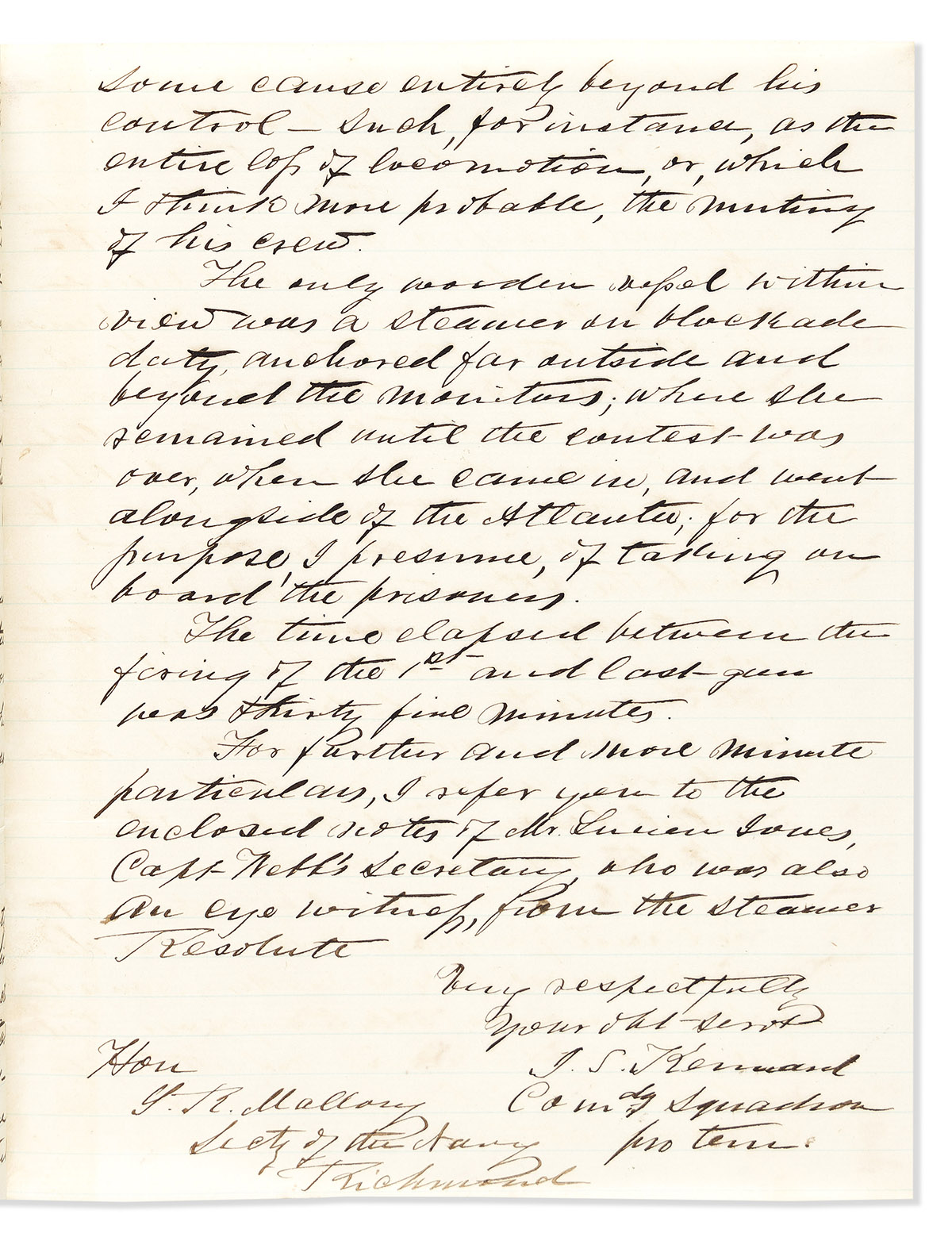Sale 2633 - Lot 50
Unsold
Estimate: $ 3,000 - $ 4,000
(CIVIL WAR--CONFEDERATE--NAVY.) Letters regarding the arrival and loss of the ironclad CSS Atlanta. 13 manuscript letters to and from Lieutenant J.S. Kennard in one folder; various sizes and conditions, most with scrapbook mount remnants on the left edge verso. Savannah, GA, and environs, 1861 and 1863
Additional Details
The ship Fingal was built in Scotland in early 1861, and was soon bought by Confederate agents for use as a blockade runner. Using a British captain and crew as cover, they successfully brought one cargo of military supplies into Savannah, but then were unable to leave port due to the increasing strength of the blockade. The ship was then fitted out as an ironclad Confederate naval vessel, dubbed the CSS Atlanta, in early 1862. In June 1863, it was captured by the Union blockading squadron, and recommissioned in early 1864 as the USS Atlanta. It was decommissioned after the war, and was sold to Haiti. As the Triunfo, it sank with the loss of all hands in 1869.
This correspondence regarding the Fingal / Atlanta was among the papers of Confederate Lieutenant Joel S. Kennard (1819-1901). It begins on 21 December 1861 with a signed Captain Josiah Tattnall order to "await the arrival of the British steamer Fingal . . . should the Fingal fail in attempting to cross the bar and be obliged to anchor below the forts, you will . . . defend her against the boats of the enemy." The next letter, 26 February 1863, relates to Kennard's acting appointment as commander of the CSS Atlanta.
The other letters are all dated May and June 1863, when a junior officer, William Webb, had been appointed as commander of the CSS Atlanta and flag officer of the Savannah squadron. Though Kennard protested this indignity, he remained in command of the smaller gunboat Isondiga and received numerous orders from Webb aboard the Atlanta. A 9 June 1863 order gave the specifications for the squadron's new pennant.
In a 17 June 1863 retained draft, Kennard reported at length on the loss of the Atlanta in a report to Secretary of Navy Mallory. Kennard had accompanied the ironclad in his wooden gunboat in an offensive against two Union ironclads: "The intention of Commander Webb in this truly daring & gallant venture, was first to strike one of the monitors with the torpedo projecting from his bows, and thus blowing her up, to turn his attention to the other." Instead, the Atlanta ran aground, and surrendered after the exchange of only four shots (described at length here). Kennard hypothesizes that Webb's surrender was due to "the entire loss of locomotion, or, which I think more probable, the mutiny of his crew."
This is followed by 4 more letters written by Kennard over the next two weeks relating to this battle. On 26 June he abstracts reports from the Atlanta's officers and crew now held by the Union as prisoners of war: "Two of the enemy's fifteen inch shot passed through the port side of the Atlanta shield, disabling two guns' crews, that a third shattered her pilot house, that she got aground and that being thus unable to bring any of her guns to bear upon the enemy, the ship was surrendered."
This correspondence regarding the Fingal / Atlanta was among the papers of Confederate Lieutenant Joel S. Kennard (1819-1901). It begins on 21 December 1861 with a signed Captain Josiah Tattnall order to "await the arrival of the British steamer Fingal . . . should the Fingal fail in attempting to cross the bar and be obliged to anchor below the forts, you will . . . defend her against the boats of the enemy." The next letter, 26 February 1863, relates to Kennard's acting appointment as commander of the CSS Atlanta.
The other letters are all dated May and June 1863, when a junior officer, William Webb, had been appointed as commander of the CSS Atlanta and flag officer of the Savannah squadron. Though Kennard protested this indignity, he remained in command of the smaller gunboat Isondiga and received numerous orders from Webb aboard the Atlanta. A 9 June 1863 order gave the specifications for the squadron's new pennant.
In a 17 June 1863 retained draft, Kennard reported at length on the loss of the Atlanta in a report to Secretary of Navy Mallory. Kennard had accompanied the ironclad in his wooden gunboat in an offensive against two Union ironclads: "The intention of Commander Webb in this truly daring & gallant venture, was first to strike one of the monitors with the torpedo projecting from his bows, and thus blowing her up, to turn his attention to the other." Instead, the Atlanta ran aground, and surrendered after the exchange of only four shots (described at length here). Kennard hypothesizes that Webb's surrender was due to "the entire loss of locomotion, or, which I think more probable, the mutiny of his crew."
This is followed by 4 more letters written by Kennard over the next two weeks relating to this battle. On 26 June he abstracts reports from the Atlanta's officers and crew now held by the Union as prisoners of war: "Two of the enemy's fifteen inch shot passed through the port side of the Atlanta shield, disabling two guns' crews, that a third shattered her pilot house, that she got aground and that being thus unable to bring any of her guns to bear upon the enemy, the ship was surrendered."

Exhibition Hours
Exhibition Hours
Aliquam vulputate ornare congue. Vestibulum maximus, libero in placerat faucibus, risus nisl molestie massa, ut maximus metus lectus vel lorem.


